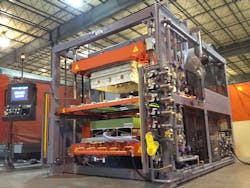Already widely used in a number of industries, asset management has proven to be a key efficiency strategy in nearly every corner of industry for several years now. For example, we have seen how Nova Chemicals used Emerson Process Controls’ AMS Suite to save hundreds of man hours during a major outage at the plant; how Monogram Aerospace Fasteners used Siemens Electronic Production Services-driven condition monitoring system to track five key CNC machine conditions and reduce maintenance resolution issues by as much as 300 percent; and how Shell used FDT/DTM and EDD to connect Honeywell’s Experion Process Knowledge System and Field Device Manager to monitor secondary transmitter temperature variables remotely, saving more than $200,000 per year.
Over the past year, we’ve begun seeing the emergence of the latest trend in asset management via the deployment of devices inside machines to track operational data and provide remote access and service opportunities by the OEM. The deployment of these devices for remote access represents not only a new technology application for industry, but a game changing way for OEMs to become more active services providers in addition to providing equipment.
One of the first devices of this type to be introduced was GE’s Equipment Insight (which Automation World first covered in this article). To develop this product, GE took the technologies it has been using for years to gather data on its own machines and equipment to create a device that OEMs can implant inside the machines they produce to collect data and provide remote services.
As Steve Pavlovsky, solutions ecosystem leader at GE, put it while visiting us to promote the launch of Equipment Insight: “There’s lots of data stranded in the machines. OEMs can provide far better support levels. And if they can find other uses for the data, they can make more money.”
A case study we published last May illustrates how Equipment Insight is already being put to work—in a grain silo, no less.
Recently, while attending Rockwell Automation Fair 2015 in Chicago, I saw another example of a remote access device designed for use by OEMs. This product, by Belgium-based company eWon, is called Cosy. Like Equipment Insight, it is a small device designed to be installed inside machines. It operates by creating an outbound-only connection across the factory LAN (via HTTPS port 443 or UDP 1194) to eWon’s Talk2M cloud-based server. This outbound-only communication via VPN eliminates plant network configuration requirements for the OEM’s customer. “No IT or firewall changes are needed to establish communication with the Cosy device,” said Dominique Blanc, general manager at eWon.
To access machine data on the Talk2M server, the OEM uses its account on the server (two-step authentication via password and text message are used to authenticate users). The information exchanged during communication is encrypted via SSL (2048-bit key). If the end customer chooses, they can control the Cosy’s VPN access to manually enable or disable the VPN connection on-site to determine when the machine is accessible by the OEM.
The Talk2M service is free for OEMs, requiring them only to pay for the device, which ranges from $700-$800, according to Blanc.
In terms of industry acceptance of eWon’s technology, the company points to several examples, including a large customer such as ABB Robotics and Chicago-based MAAC as a mid-sized OEM application.
ABB Robotics is using eWon’s technology to provide remote services on its robots. The use of the device in ABB Robotics case differs a little in how data is sent versus the typical OEM Cosy application. In ABB Robotics’ case, the eWon M2M router logs a robot’s key performance data and sends it to an ABB service center via GPRS technology as part of ABB’s Remote Service. When a GPRS network is not available, ABB Robotics connects the robots to the ABB service center using Talk2M. With Remote Service, the robot (via eWon technology) automatically alerts the on-call service engineer, who can access detailed robot data and identify the root cause of the fault. The robot’s information is reviewed, analyzed and reported to customers by ABB as part of its service.
Blanc noted that eWon’s technology is currently operational in 30 countries for ABB Robotics.
Representative of the more common application of Cosy is MAAC, a manufacturer of thermoforming machinery. MAAC’s products are used around the world in industries such as aerospace, medical, and automotive.
Leslie Adams, director of technical Services at MAAC, said the company has used Cosy to establish secure VPN connections with its machines in factories ranging from Calgary to North Carolina and from Minnesota to Montreal, as well as more distant sites in China, India, and Australia. “As long as the customer has an Internet connection, we’re good to go,” said Adams.
The remote access provided by Cosy enables MAAC to connect to their machine and access PLCs, drives, HMI devices and any other device connected to the machine subnet, including an IP camera.
Remote maintenance capabilities have enabled MAAC to perform quick and efficient troubleshooting, which has had a very positive impact on its customer support costs. “With eWon, we eliminate 50-70 percent of our support costs, in addition to significantly reducing hours of machine downtime normally associated with waiting for a service technician,” said Adams.
Leaders relevant to this article:


